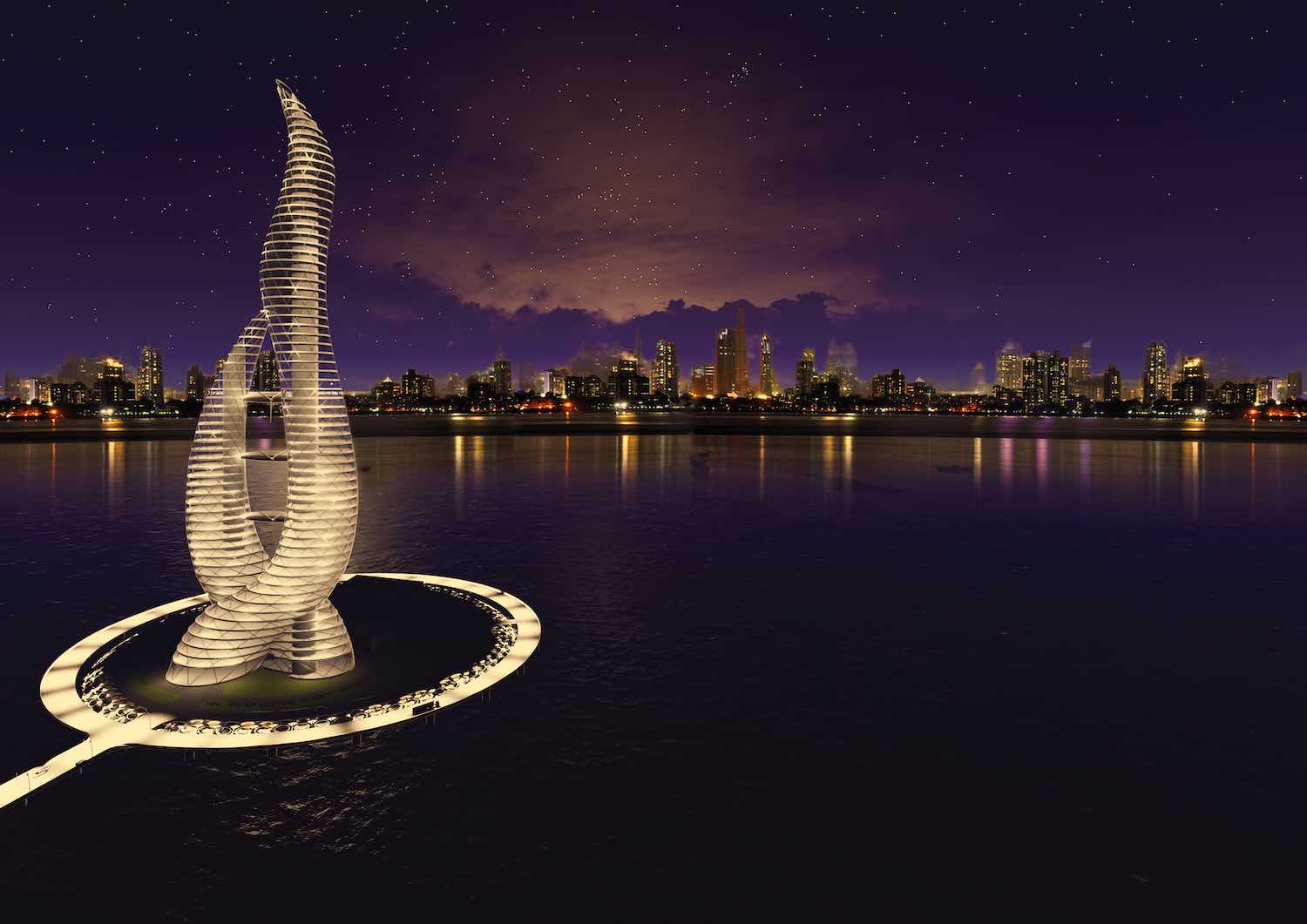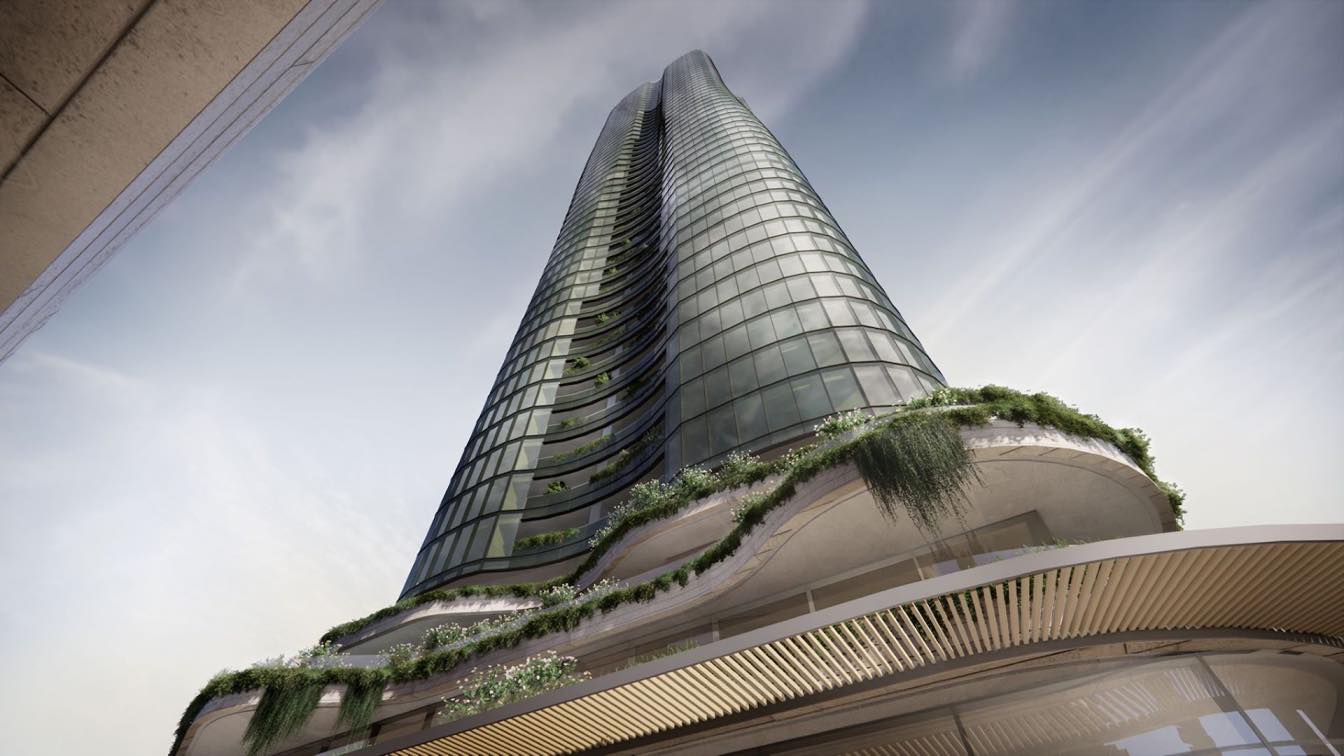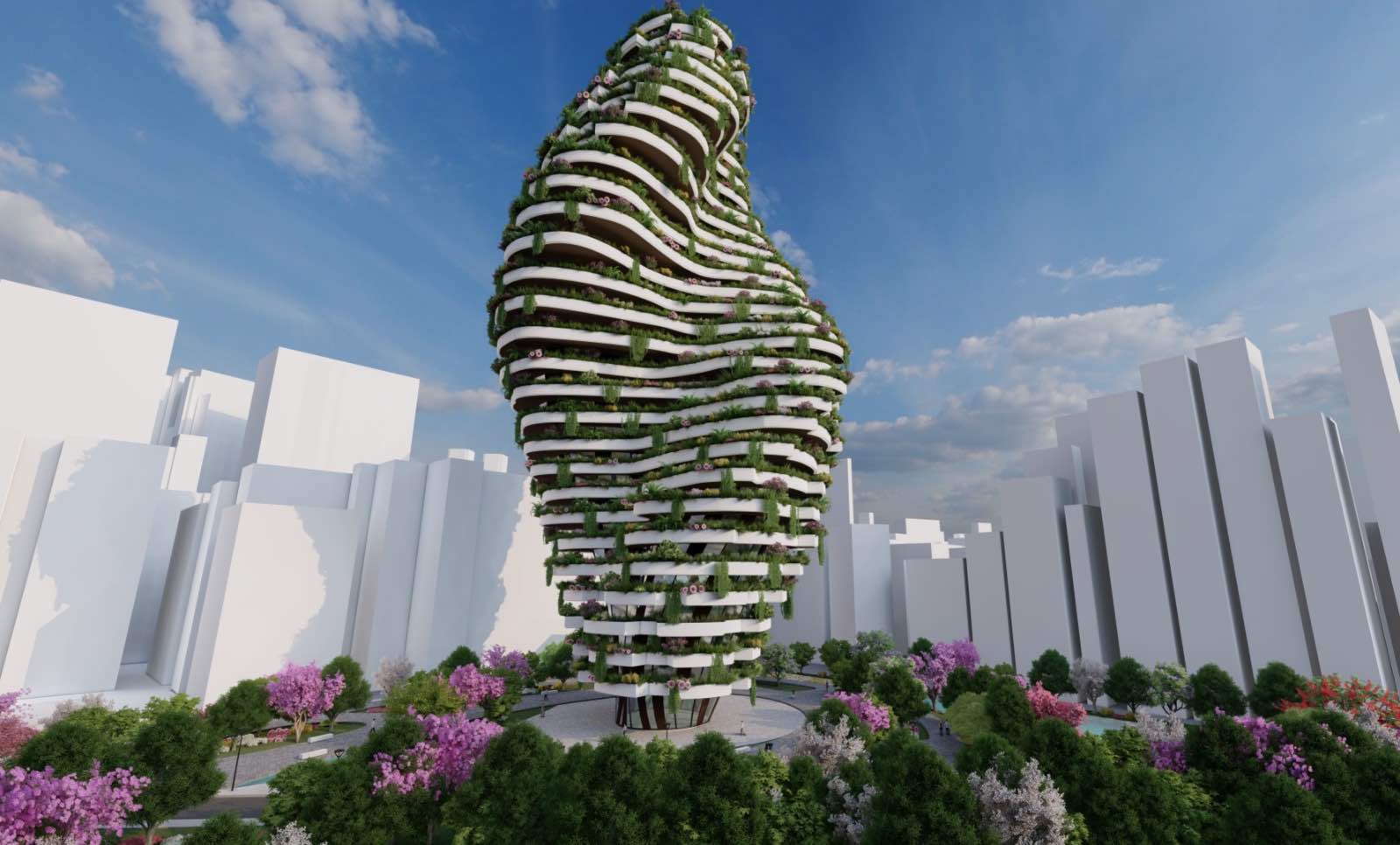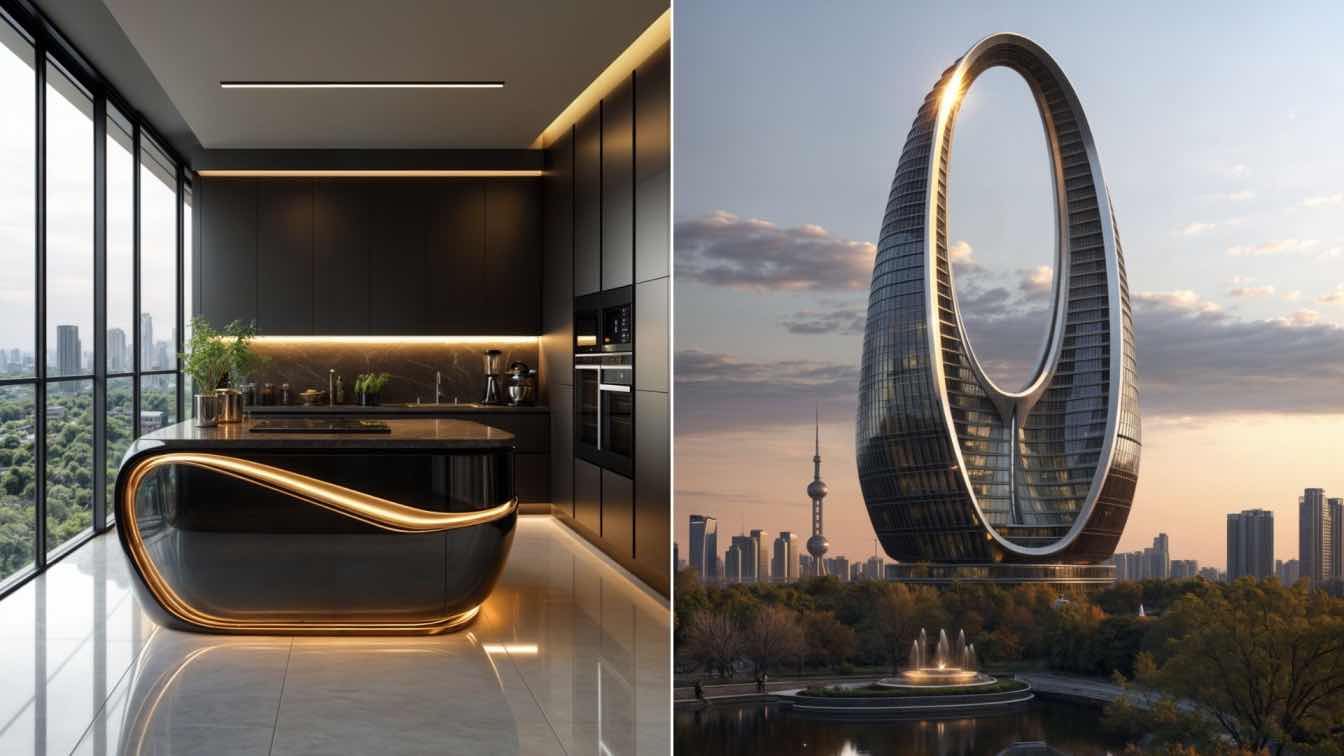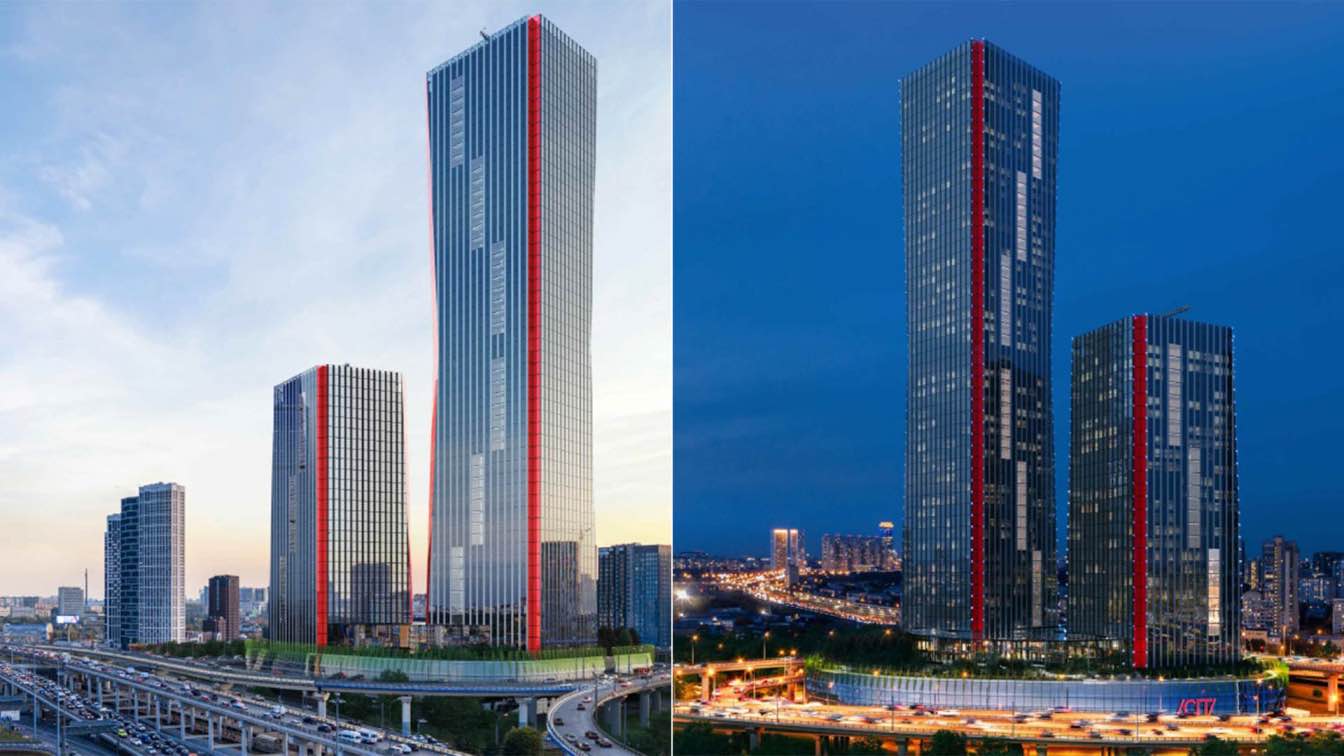The Indian architect Vaishaly from Doodle Studio has designed ''Bollywood Heights'' a proposal for a vertical film city. The setting of this story is in the Mahim Bay, a bay that is a part of the Arabian Sea in Mumbai. This tower stands on an artificial island as a net-zero energy building it will be self-efficient to generate energy for its use and will also help in cleaning water of the Mahim Bay.
Project description by the architects:
Introduction
Pacing along the kutchha streets of Indian villages to the high end roads and flyovers of metropolitan cities, we never fail to get the reflection of India’s most influential industry called Bollywood. Be it the blockbuster movie poster hoardings near traffic lights, or the Bollywood star brand endorsements on flexes in front of our favourite gol gappa stalls, Bollywood is found everywhere in India. Bollywood, a term used to refer to the whole of Indian cinema, has been in the hearts of Indians from over a hundred years.
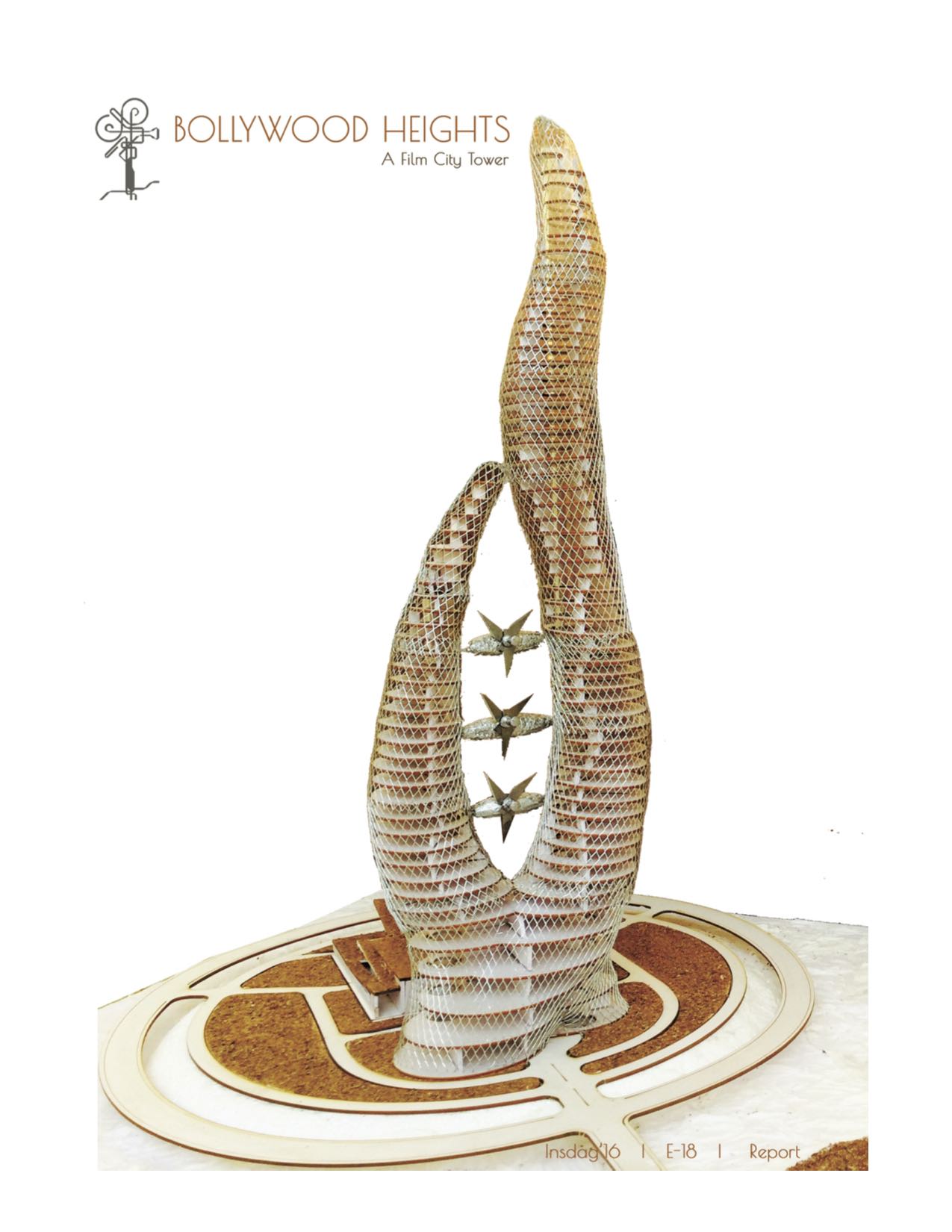
‘Bollywood Heights’ is a design proposal for a vertical film city under the cover of a thesis project. The setting of this story is in the Mahim Bay, a bay which is a part of the Arabian Sea in Mumbai. This project will fulfil all the challenges and space requirements of a horizontal film city, in a vertical fashion, without causing the problem of availing real estate in the highly occupied city of Mumbai. This city is the home of Bollywood, where billionaire stars to struggling actors, all reside to work for the industry. The surrealism surrounding Bollywood is almost synonymous with the cultural ethos and is ingrained in the aspirations and lifestyle of common people across India. It has the emotional power to sway and swing millions of people. Bollywood is a goliath in terms of revenue generation and employment, both direct and indirect, supporting a multitude of auxiliary industries like tourism, music, design and fashion, being a significant contributor to the national GDP. Also standing as a net-zero energy consuming building it will be self-efficient to generate energy for its use and will also help in cleaning the water of the Mahim Bay.

Topic
Wikipedia states “A film studio (also known as movie studio or simply studio) is a major Entertainment Company or Motion Picture Company that has its own privately owned studio facility or facilities that are used to make films, which is handled by the production company.” A film studio consists of all the equipment and facilities required for pre- production, production and post-productions plus a primer theatre.
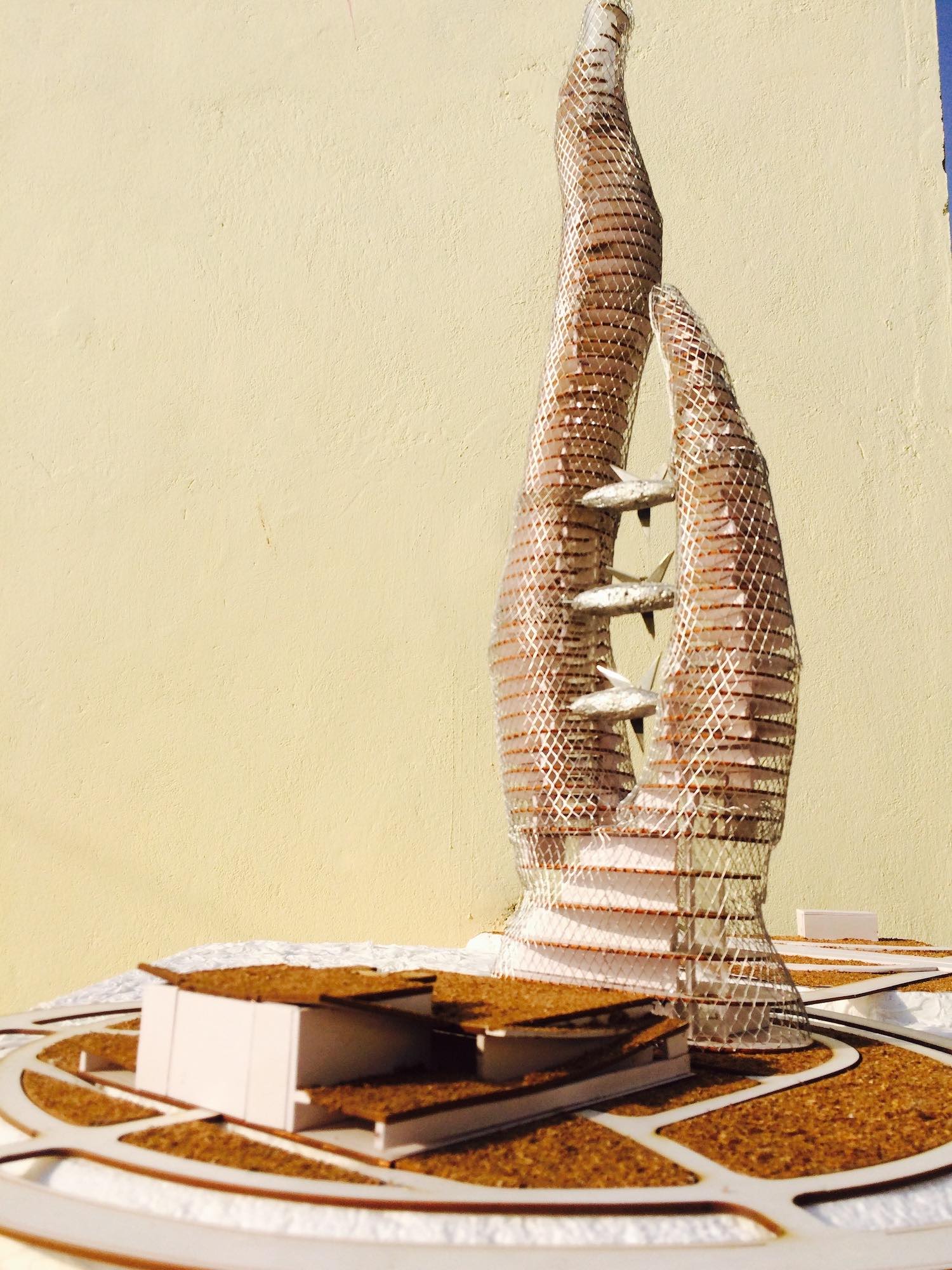
Film studios, in their inception, have had only indoor and outdoor shooting facilities. The advancement of technology brought major changes in the field of film making. Animation techniques, such as green screen technology and development of sound system, have given the touch of reality. In film studio, we can find all the facilities required which include office spaces, residence facilities for actors and other technicians. In a film studio one can shoot a movie in a very fast pace as one can construct different indoor and outdoor scenes quickly by using the workshop facilities available.
Bollywood, since a while, has needed both an iconic status that can be physically appreciated along with more facilities to accommodate budding film-makers.
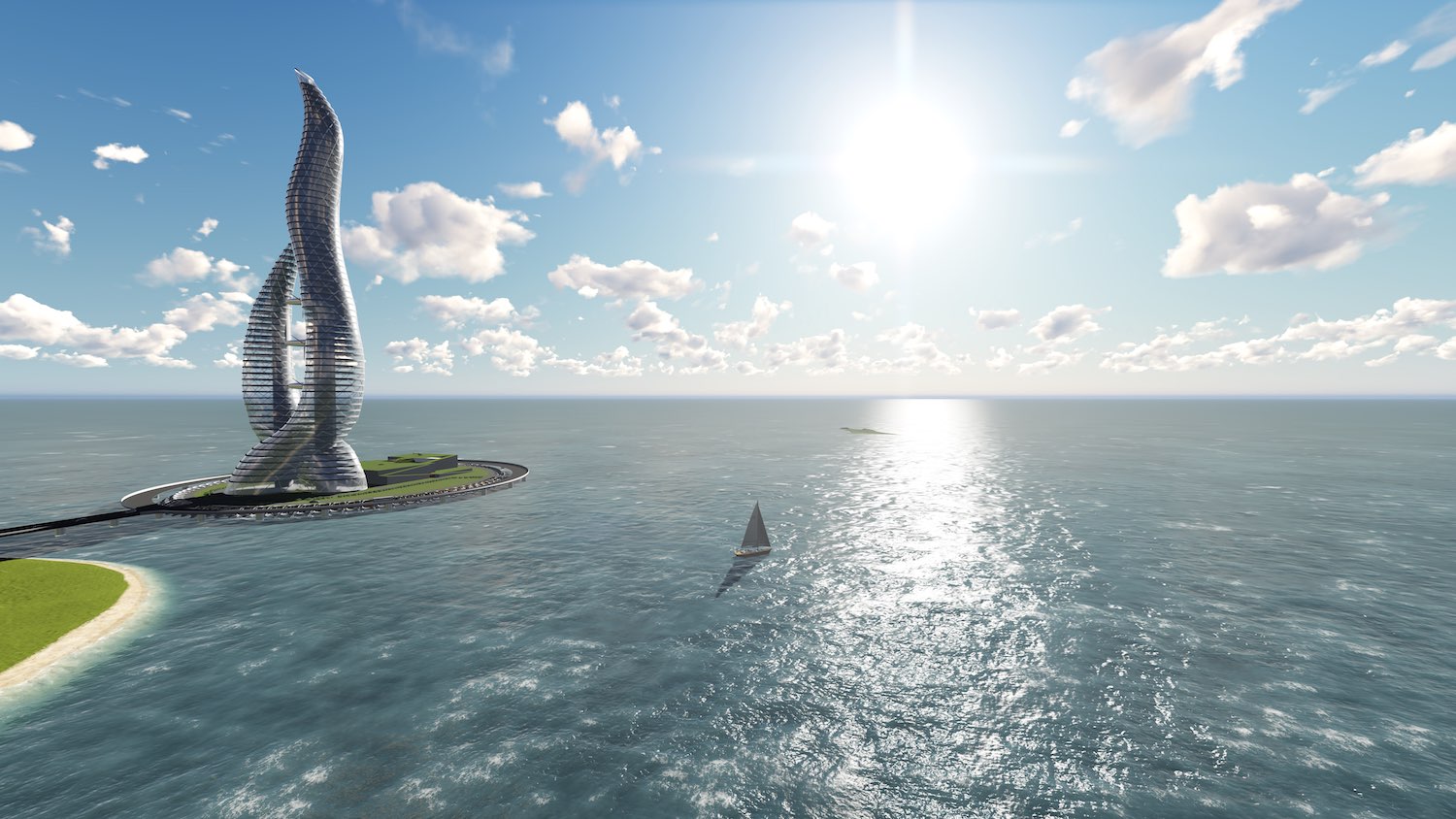
Reason
Need for a Vertical Film City
Verticality achieves a few things by the virtue of its height alone. It becomes a visual icon and saves ground cover. These ideas have been virgin to the film studio layouts as they have never been stacked in a vertical tower. But if in place like Mumbai, where there is a constant scarcity of land and is also a place for sporting high-rise towers for the nation, the proposal and need arise and complement each other.
The aim is to identify the land and service intensive functions of a film city while compacting and transforming them into a vertical tower that would generate an exemplary urban form. It is needed today in a time of land scarcity and technological advancement. A challenging and compelling design can always push forward the creativity in architecture.
It should firstly have an identity, secondly tackle all city problems and enrich the life of the residents around it. The centre has multiple land use, which can broadly be categorized into commercial, educational, recreational and public building therefore integrating and unifying common interests. All such requirements in a Mumbai site can be reflected as an efficient design programme where parking podiums, high-rises, mixed-use buildings and film making are common place.
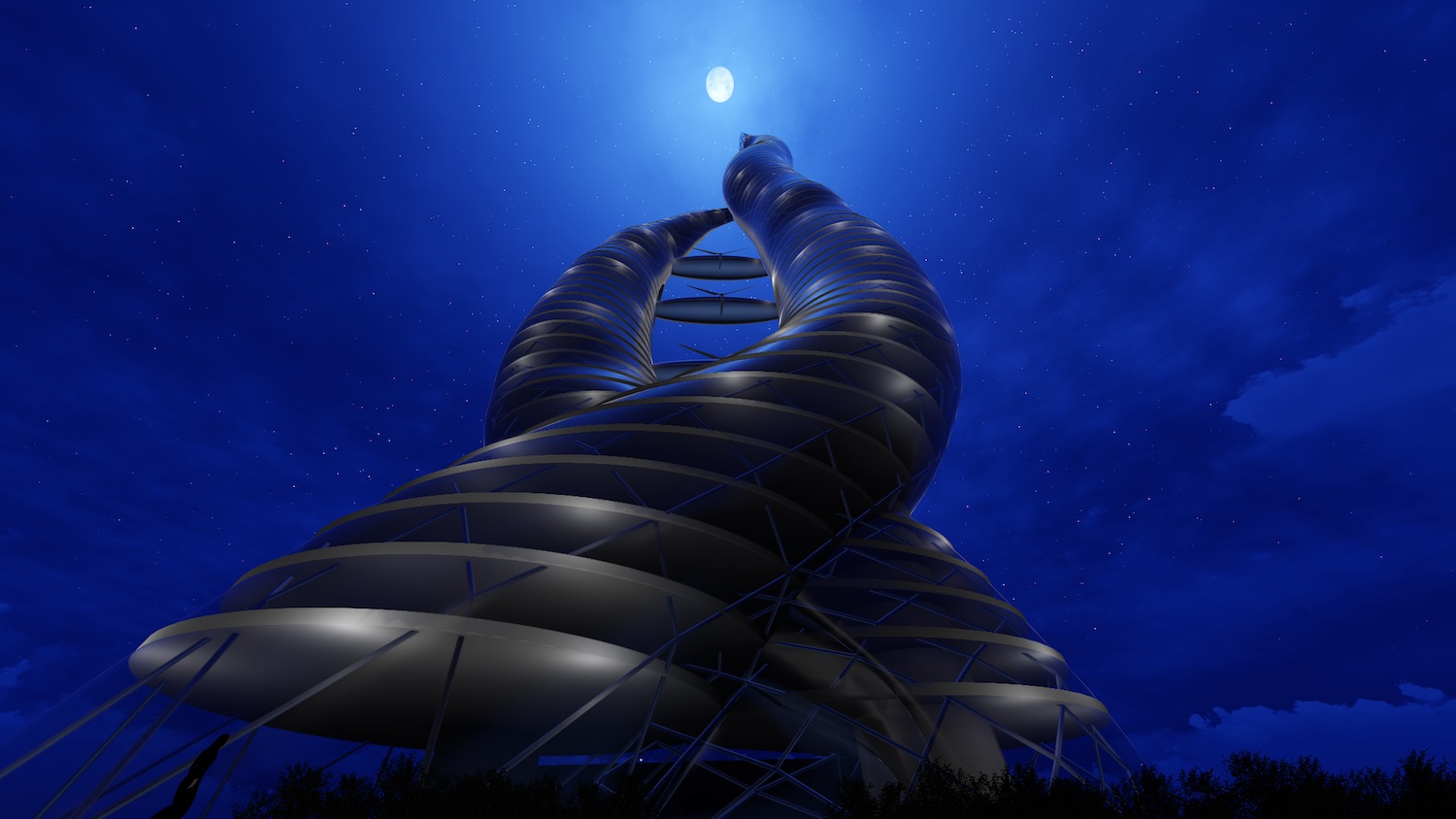
Proposition
BOLLYWOOD FILM CITY TOWER, MUMBAI EXPLORING A VERTICAL TYPOLOGY FOR A FILM CITY
To design a ‘Film City Tower’ in Mumbai that explores the possibility of a new vertical typology for a film city creating an iconic landmark for Bollywood and its city.
The thesis is thus an attempt to answer: What Makes an Iconic Film City?
How Can a Film City be planned vertically?
The three nodes of this design proposition fall in place with each other where the Bollywood Film City’s need for an icon is complemented with an architectural challenge of exploring a vertical typology for a film city. And the need for such a high-rise project is common in Mumbai which is incidentally the focal point for Bollywood is making this conceptual project feasible by choosing it as a site.
Site: An artificial island in Mahim Bay, Mumbai.
Source: Yamaha Corporation via an open international competition hosted by Archasm.
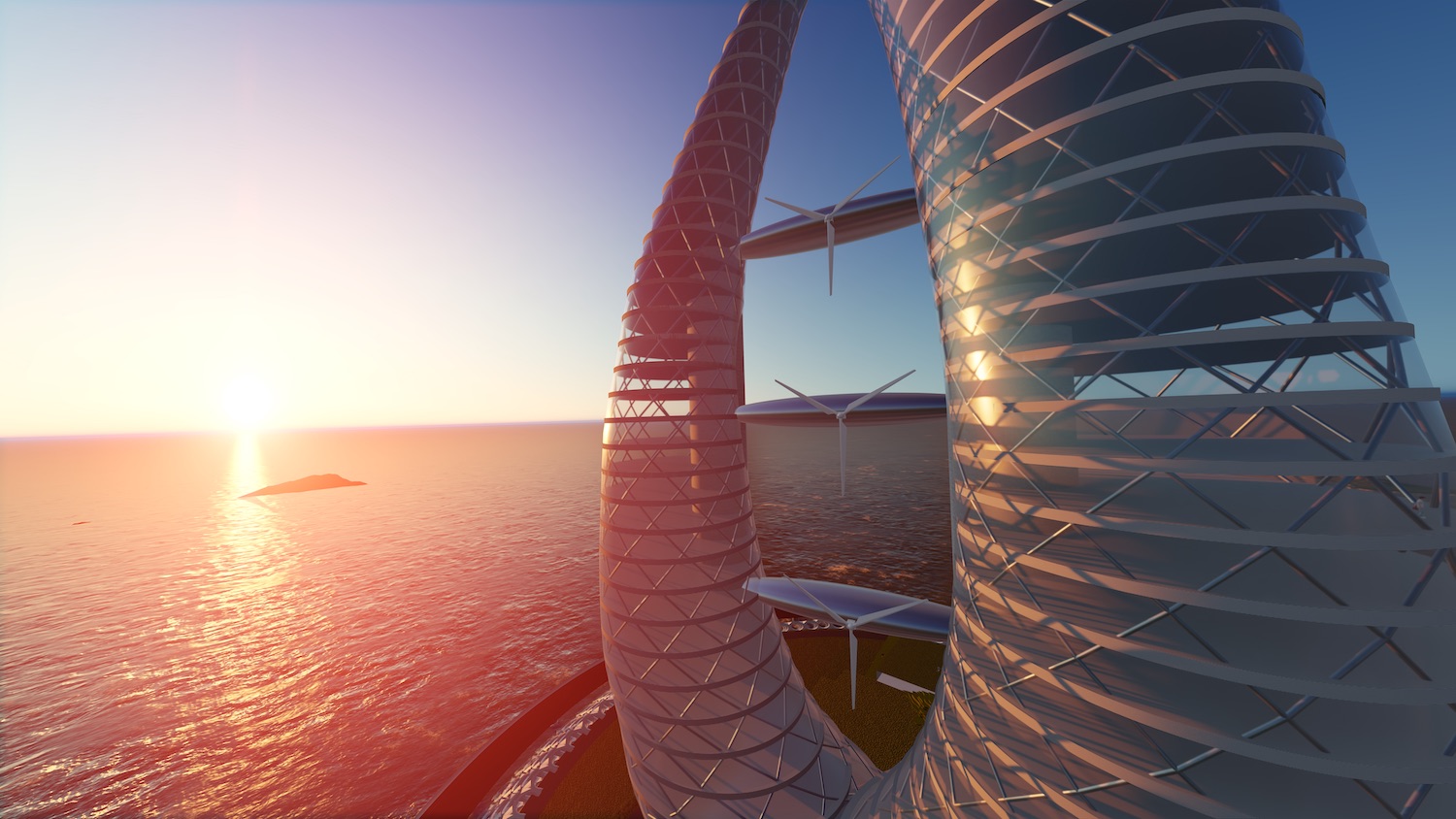
Aims and Objectives
Translation and appropriation of the components of a Film City in an innovative vertical tower typology Creation of a contemporary icon for Bollywood and the city of Bombay The Film City Tower aims to provide some necessary facilities that a fully functional film city requires.
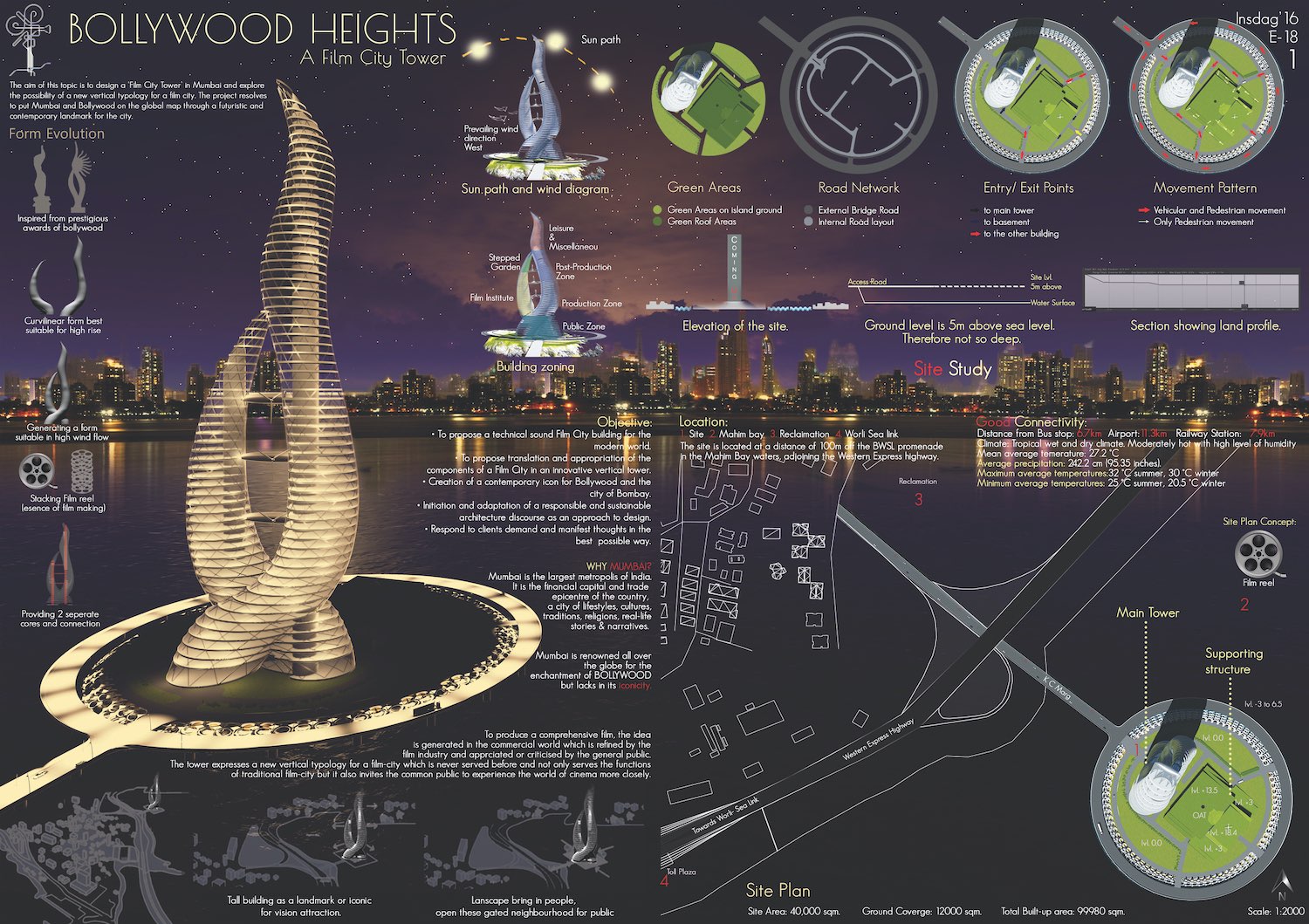
Scope of Work:
FILM PRODUCTION •Sound Stages •Production Accommodation- Make-Up Rooms, Costume/Wardrobe facility, Dressing/Changing Rooms, Arts Department, Workshops(plastering, carpentry, props, paint, steel work etc.), Utility/Storage, Actors’/Producers’ Rest rooms, Lounge areas for junior artists etc. •Post Production- Video Editing studios (linear/non-linear editing rooms, online/offline editing rooms, VTR rooms, VFX production room, Colour Grading studios), Recording theatres, Audio Editing studios (Foley studios, Dubbing studios, Re - Recording studios), Screening theatres, Archival and Restoration facility, Media Transfer facility. FILM SCHOOL Shooting Floors, Acting studios, Dubbing studio, Photography studio, Multimedia laboratory, Library, Auditorium/Theatre, Dance/Music studios, Equipment laboratory, Cafeteria, Workshops, Reception and Conference area, Faculty rooms etc.
SOCIAL AND LEISURE/MISCELLANEOUS Bollywood Museum, Movie theatres, Exhibition areas, Cafes, Restaurants, Retail and Tuck shops, Children’s gaming and play zones, Administrative areas, Vertical circulation cores, Landscape zones and other types of gathering spaces etc.
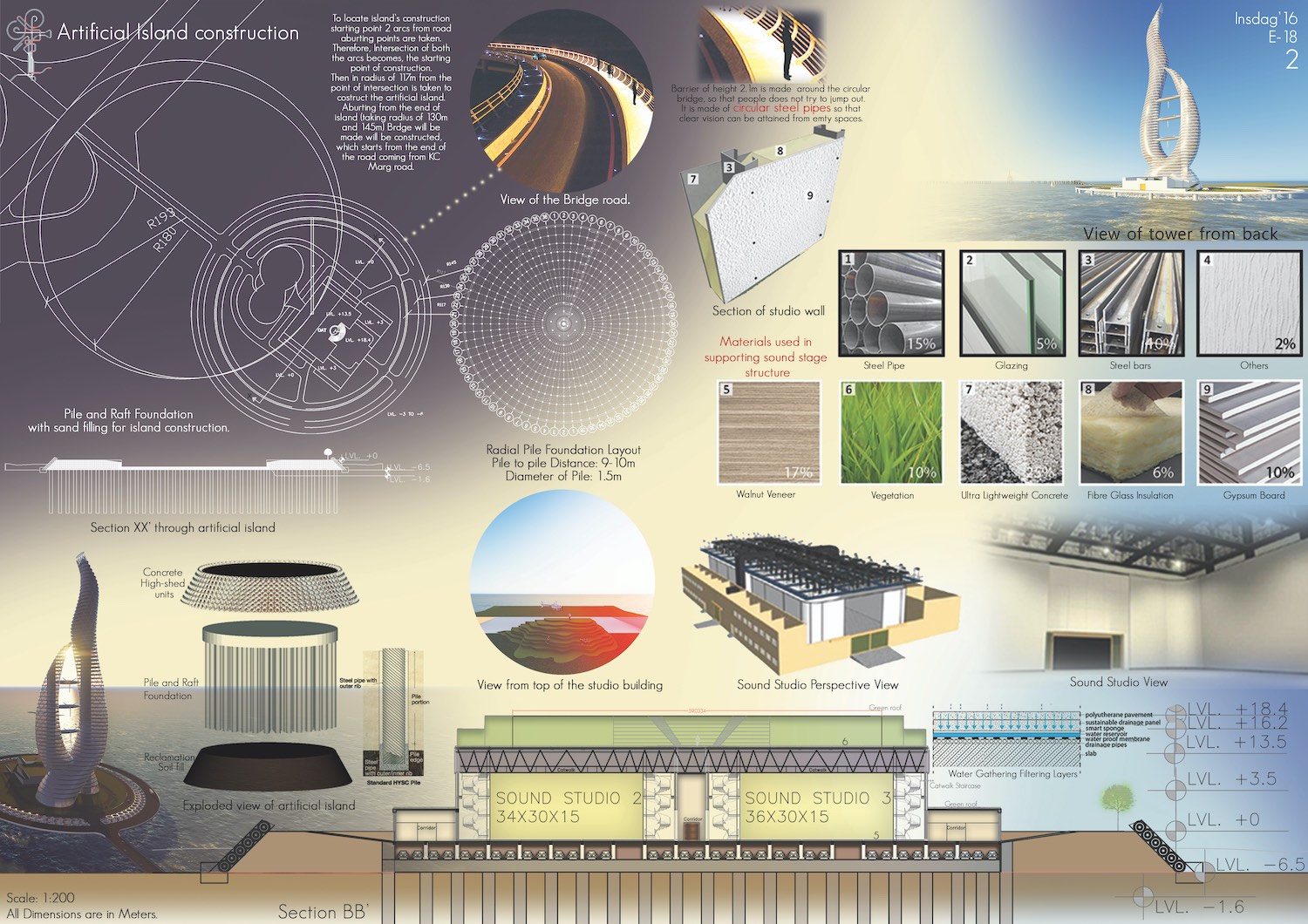
Limitations:
The big sound stages where set making is done and parking is provided in a ground floor structure at the back of the main tower which is covered with landscaping on the top. It is very difficult to transport huge sets and materials to such a height in a tower as extra machinery, lifts and carriers needs to be installed which can take huge amount of space in the tower interrupting other services in the tower.
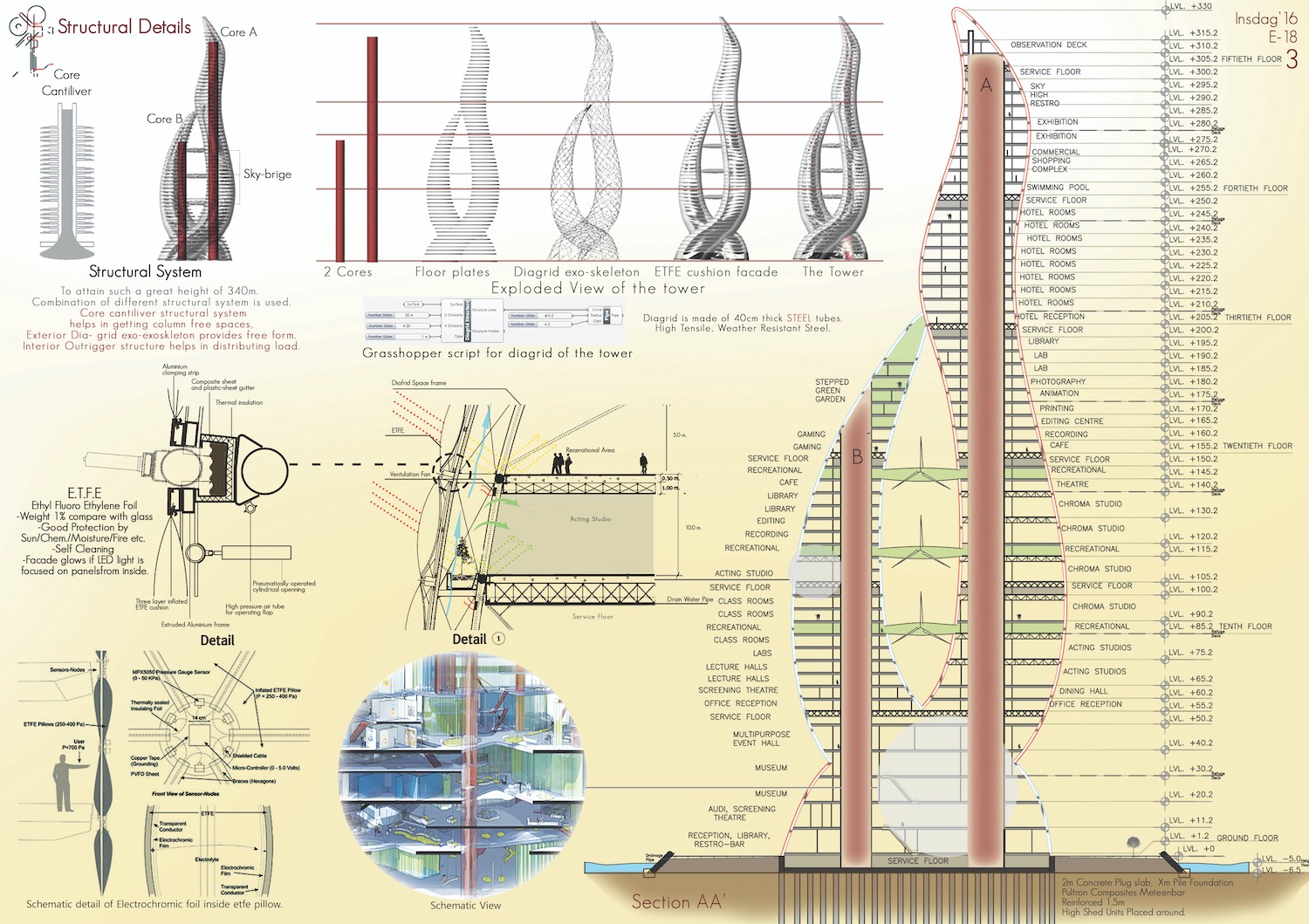
Areas of Research:
The Film City Tower aims to provide some necessary facilities that a fully functional film city requires. The tower has multiple land use, which can be categorized into commercial, recreational and public zones. The program includes a multitude of functions such as a Bollywood Museum, Production houses and a Film School which requires a segregated but unified approach to the program needs.
Hence, one of the major research topics would be the study of the process of film making and the various stages of producing a film. Secondly, the components of a film studio, spatial and technical details of various film studios and workshops. Another important research topic as per the challenges provided in the planning of a vertical typology involve the construction of a vertical structural system, island construction and sustainability in high-rise.
Areas of Research:
Primary research: 2.1.1 PROCESS OF FILM MAKING
Secondary research: 2.1.2 PRODUCTION FACILITIES
Tertiary research: 2.1.3 STRUCTURE AND TECHNOLOGY
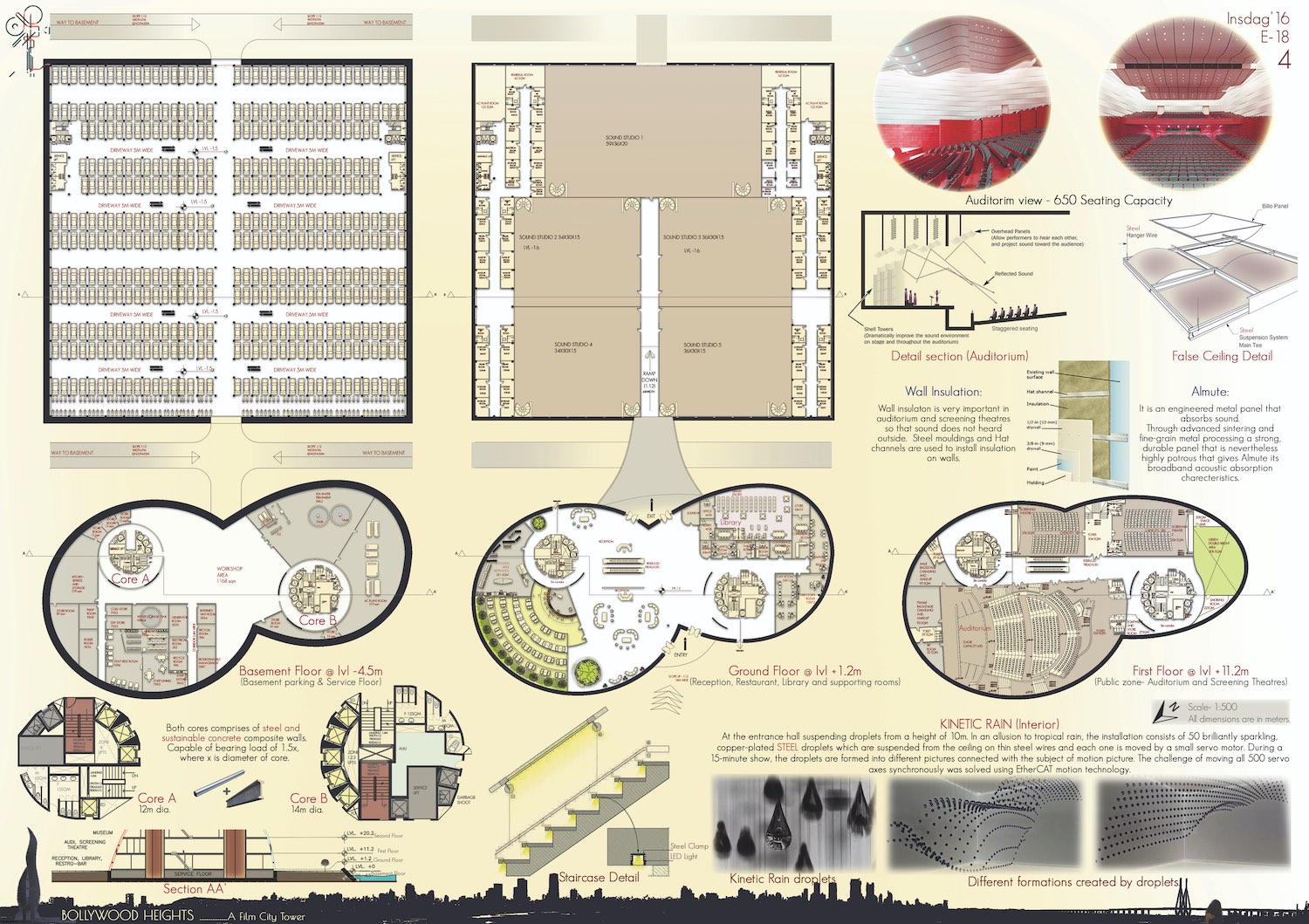
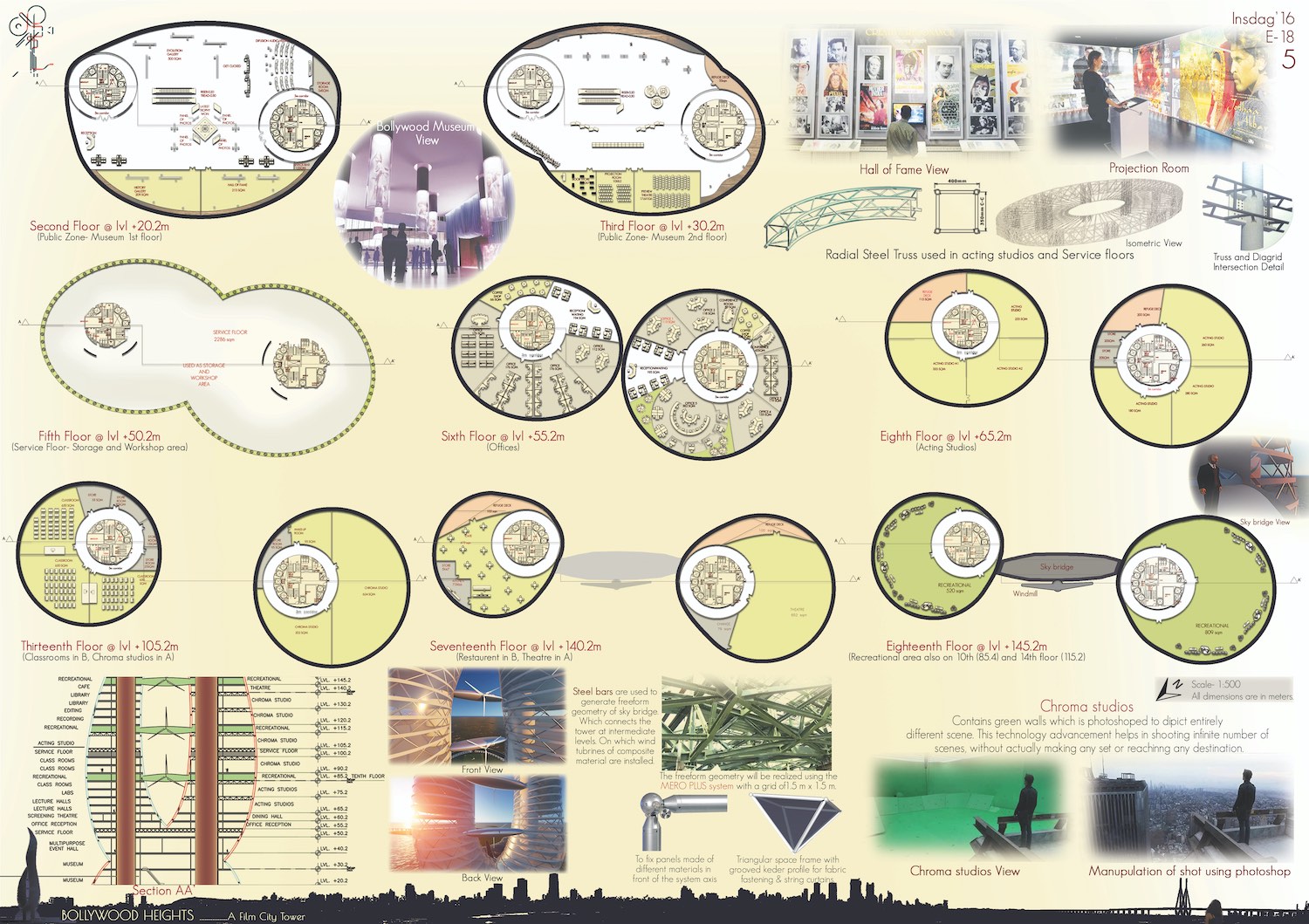
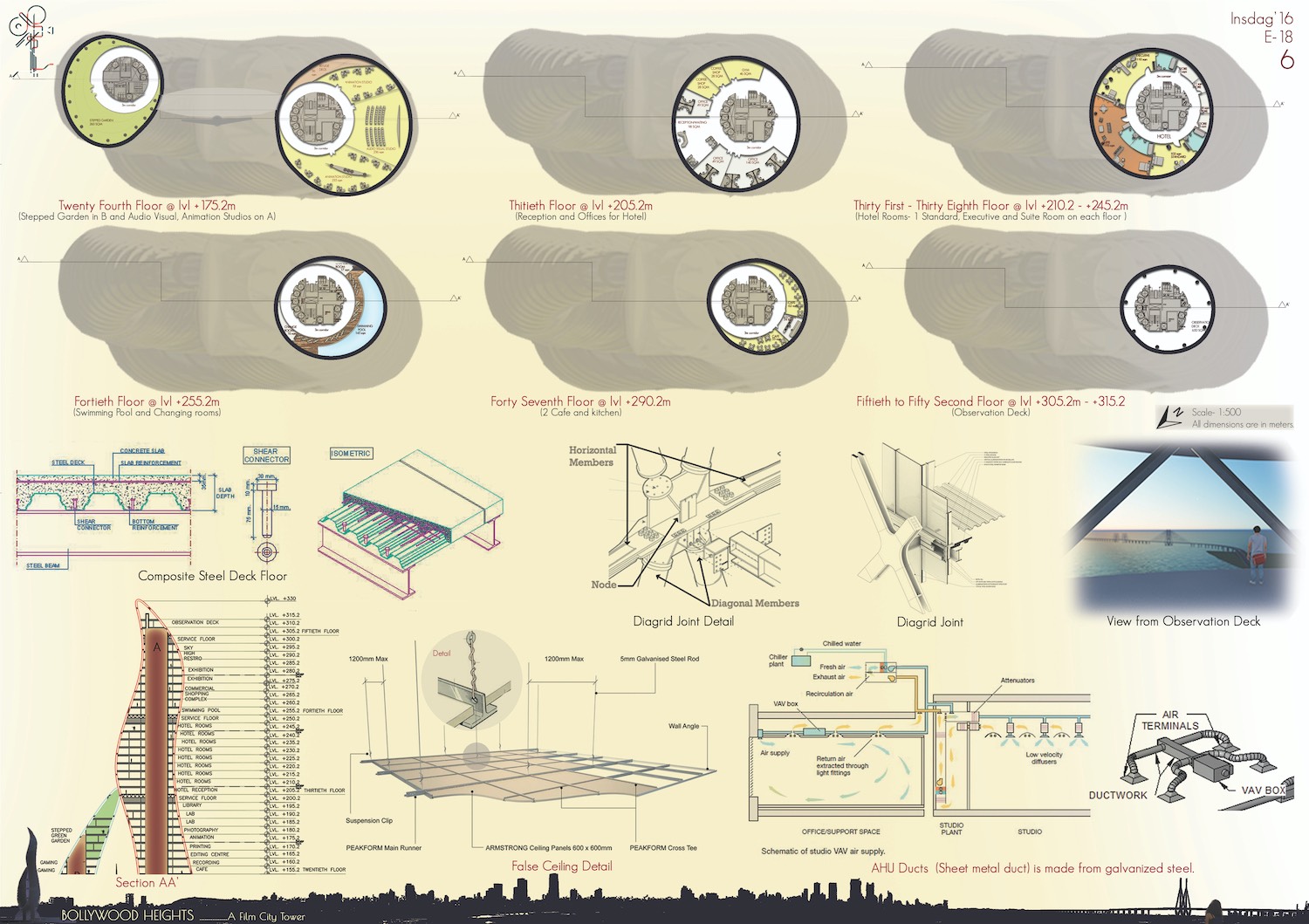
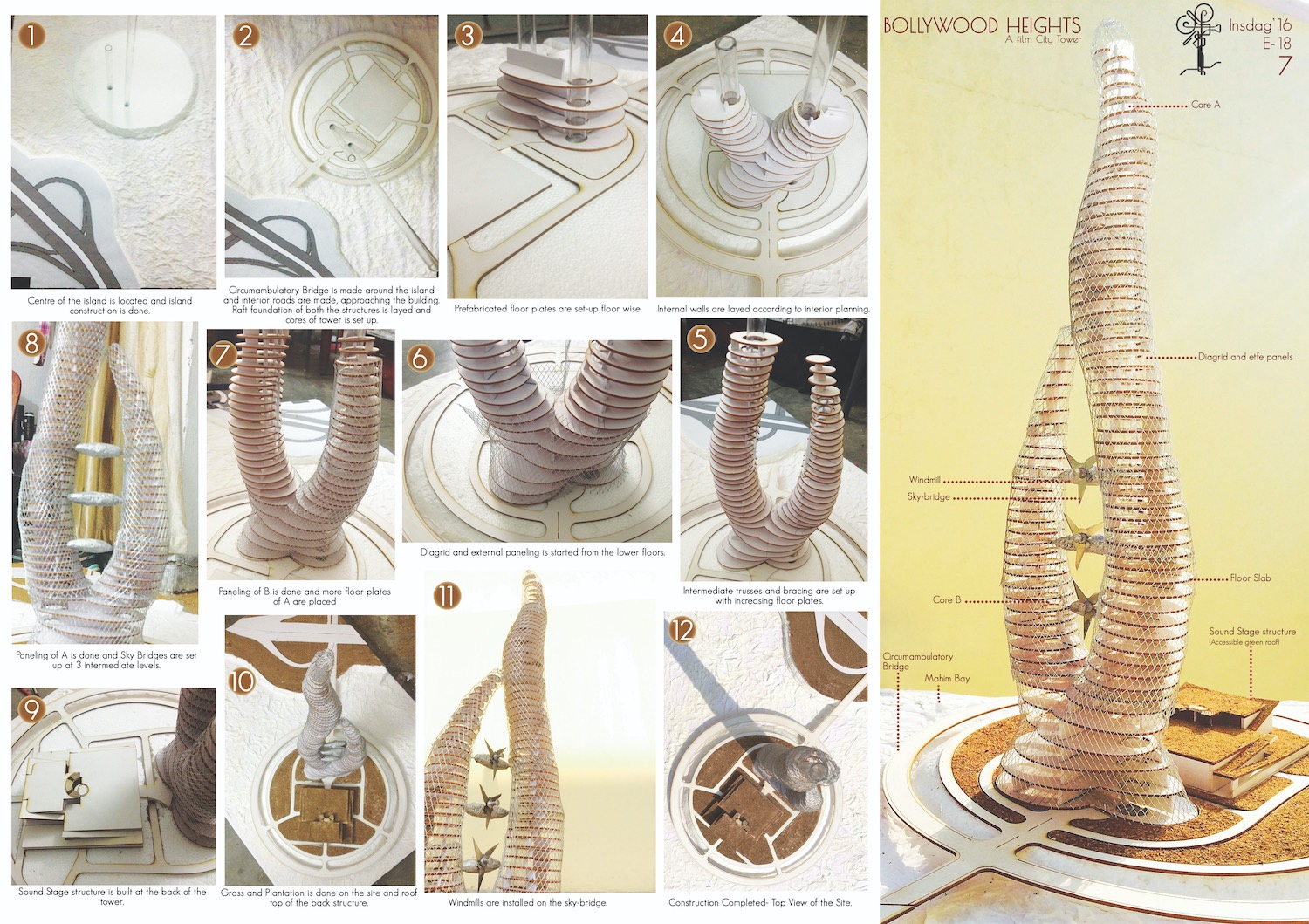
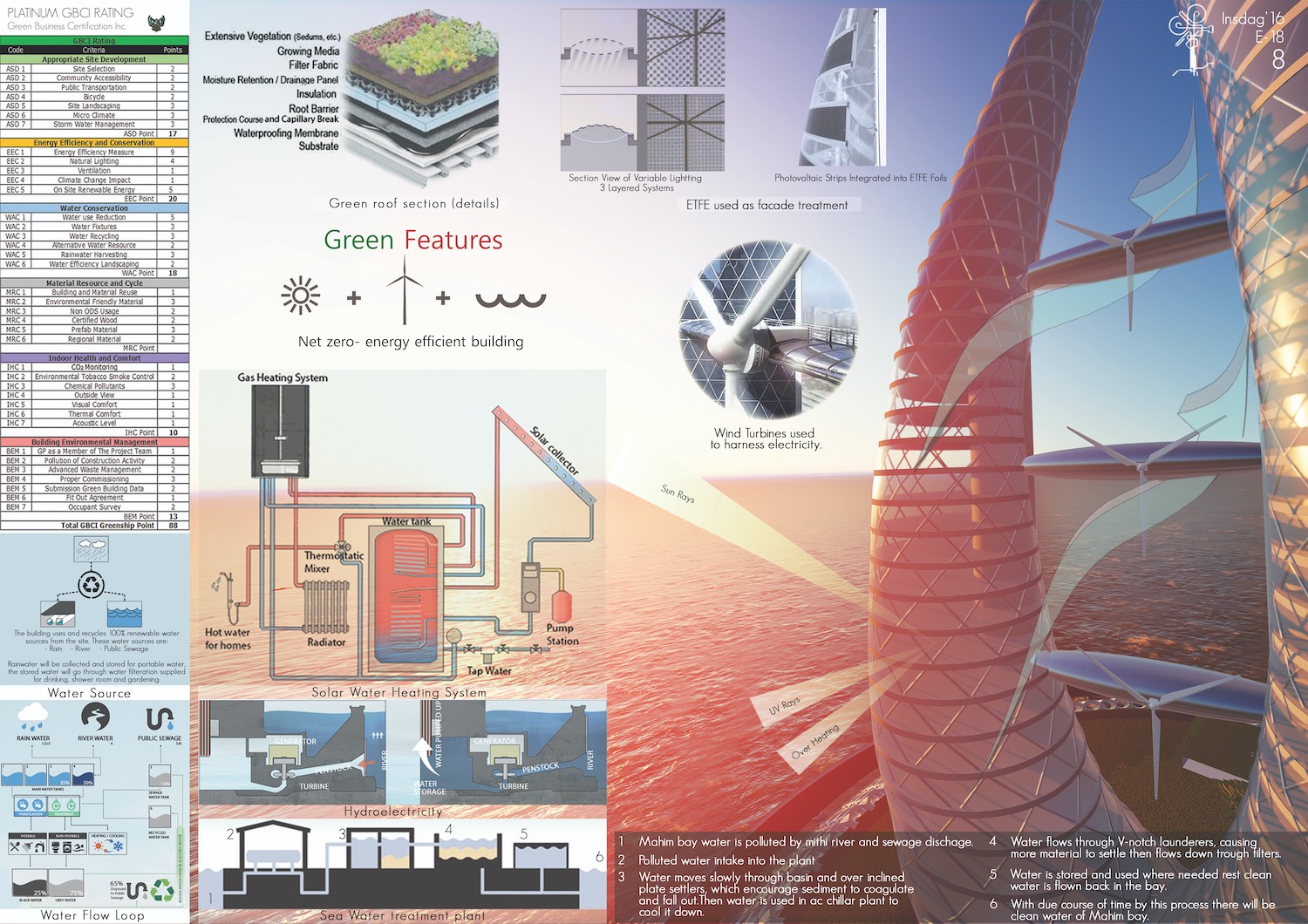
Case Studies:
-
1) Dadasaheb Phalke Chitranagri, Goregaon, Mumbai – Horizontally spread film city.
-
2) Whistling Woods International, Goregaon, Mumbai – Film Institute.
-
3) Atmosphere, Super-luxury Apartments, Kolkata – High-rise Residential Building
with miscellaneous activities.
Literature Studies:
-
1) Ramoji Film City, Hyderabad - Horizontally spread film city.
-
2) Film & television institute of india , pune– Film Institute
-
3) Burj- Al- Arab, Dubai – High-rise Hotel Building with miscellaneous activities
a. Basic functional requirements.
Site Analysis
Project: Bombay Heights, Film City Tower Location – Mumbai
Location: Mahim Bay, Mumbai
Site Area: 40,000 sqm
Maximum Ground Coverge: 12000 sqm.
The site is located at a distance of 100m off the BWSL promenade in the Mahim Bay waters, adjoining the Western Express highway.
Climate: Tropical wet and dry climate. Moderately hot with high level of humidity
Mean average temperature: 27.2 °C
Average precipitation: 242.2 cm (95.35 inches)
Maximum average temperatures: 32 °C (90 °F) in summer. 30 °C (86 °F) in winter
Minimum average temperatures: 25 °C (77 °F) in summer 20.5 °C (68.9 °F) in winter
WHY MUMBAI?
Mumbai is the largest metropolis of India. It is the financial capital and trade epicentre of the country, a city of lifestyles, cultures, traditions, religions, real-life-stories & narratives. Mumbai is renowned all over the globe for the enchantment of BOLLYWOOD, which is the nickname given to the Hindi Film Industry located in the city.
Why not any other city when mumbai already has a ‘film city’?
The neighbourhood of film city occupies prime land in the heart of Bombay, but has lacked the globalism and iconicity portrayed by the neighbourhood of Hollywood in Los Angeles, which houses all the legendary studios, theatres and film production units across its bay.
The cooler season from December to February is followed by the summer season from March to June. The period from June to about the end of September constitutes the south-west monsoon season, and October and November form the post-monsoon season. Temperature difference b/w surface & depth of 1000.
SWOT Analysis
The prime location of the site in the Mahim Bay is accessible through the KC Marg and is in a visual connection with West Bandra and the Bandra-Worli Sea-Link. The site is disconnected from the land and traffic and a dedicated entry allows for a secluded environment for the tower. The site demands a considerable amount of pedestrian access making it more accessible as an extension of the promenade.
The site needs a creation of artificial island and pile foundation to stabilize the skyscraper on sand. The services and other heavy vehicles must be transported to the artificial island which require proper road systems. The main connection with the city is only through vehicular and pedestrian connections which don’t provide a greater level of interaction.
The artificial island gives a scope for building without any restrictions pertaining to the adjacent buildings. The tower can be visualized in an exotic context with possibilities of providing viewpoints on all sides. The pedestrianization of the site can lead to a program which encourages public spaces on the lower levels of the tower.
The tower needs to be planned with respect to the sea wave activity and requires caution. The ever-increasing parking problem needs to be resolved both in the site and in the area allocated in the Reclamation zone, off the site.
OPERATIONAL ISSUES AND CHALLENGES OF A FILM CITY TOWER
Film studios often require complex management structures, but the objective should always be to keep the structure as strong and straight forward as possible. Two overriding questions should be addressed upfront in establishing a management plan when multiple ownership is considered. How will service be provided to various systems of the building? How can the detailed operating needs of each use be best served in the overall development and management plan? The major issues that are identified are as follows: Land Reclamation Efficient parking system without going underground. Separate entries to various types of people entering the film city. Column-free studios inside the tower. Refugee areas and service floors. Efficient core. Lift requirement and service circulation.
Material Palette
-
Steel:
-
Mild Steel Rolled Sections including Beam Sections, Channel Sections and Angle
Sections etc.
-
Mild Steel Fabricated / Built-up Sections
-
Rectangular, Square & Circular Hollow Sections
-
Plates and Flats, Rounds and Squares
-
Wire Ropes, Steel Pipes
-
Corrugated /Plain/ Embossed Profiled Sheet
-
Colour Coated/ Plastic Coated/Galvanized Sheet
-
Stainless Steel Sheet and Sections
-
High Tensile Steel, Weather Resistant Steel etc.
-
-
Etfe Panels, Glazing glass.
-
Walnut Vineer, Vegetation,
-
Ultra lightweight concrete, Fibre glass insulation, Gypsum Board
Brief Design Concept
Bollywood Film City Tower is a conceptual design idea exploring a completely new vertical typology for film studios that have been traditionally planned over large sites. The site proposed is an artificial island of 4 hectares in Mahim Bay, Mumbai, the hometown of Bollywood, where land scarcity, land reclamation and high-rise buildings are common place. The iconic aspect of the tower is its shape like a trophy, gigantic proportion which metaphorically stands for inspiration to the filmmakers. It also represents glory, a flame and the shape like trophy itself represents the concept of ‘muse’. The facade is also supported with a diagrid along with ETFE panels. The program developed after the case studies of both film studios and high rise buildings incorporates a film school and public Bollywood museum alongside film production making it a mixed typology. The ground cover is 1.1 hectares (30.5%) which is majorly used for service areas. The flyover reaching the site is redesigned and separate entries have been accommodated based on the visitors who are later segregated. The site consists of two structures one is the Tower itself and the other one consists of 5 huge sound studios with basement parking. This structure is covered with green roof. Therefore, it doesn’t hamper the view of the tower. Whereas, the main tower is divided into 5 major zones: Public areas are in the lower floors, the film institute is in ‘B’ wing of the building and ‘A’ wing consists of production, post- production, leisure and miscellaneous and recreational areas. The concept itself is working with so many constraints which have shaped the function and form of the building with a whopping built-up area of 10 hectares. The building is designed in such a way that it generates its own energy for its use and thus, becomes a net zero energy building. It is 330m high tower with 3 huge wind turbines on three different nodes, to harness electricity. The service floors, refuge areas and other programmatic requirements are duly addressed to make the building as functional as possible. The skyscraper aims to create space for enthusiastic film makers to explore filmmaking and learning just like any other film city while the form creates an icon for Bollywood.

